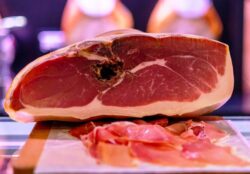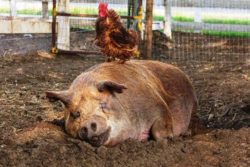Read Time: 6 Minutes Subscribe & Share
Ham Histories
Since I now reside in one of the reigning ham regions of the world, I have thought about the ham in my state of Virginia. It came up in a heated conversation (I was listening, rather than actively participating) among a group of Italians over the merits of various Prosciutti crudi and which one had the best flavor, aroma, texture – aspects upon which Italian citizens have very pronounced opinions. Then someone popped the question to me about whether we had a good ham at home – I thought I detected a note of sarcasm in the question, but I may have been overly sensitive. And while Italians memorize their history, and we seem not to, I thought it would be best to offer some research.
ham in my state of Virginia. It came up in a heated conversation (I was listening, rather than actively participating) among a group of Italians over the merits of various Prosciutti crudi and which one had the best flavor, aroma, texture – aspects upon which Italian citizens have very pronounced opinions. Then someone popped the question to me about whether we had a good ham at home – I thought I detected a note of sarcasm in the question, but I may have been overly sensitive. And while Italians memorize their history, and we seem not to, I thought it would be best to offer some research.
Yes, Virginia, We Have Ham
 And yes, we do have a famous ham with an interesting history and traditional ways of preparing it. When the first English settlers set up camp in what became Jamestown, Virginia in 1607, they had brought with them some hogs. How they managed to fit not only razorback hogs, but also cattle and horses in those tiny ships is a testament to living in close quarters. While other livestock require pasturage, hogs will eat just about anything and thus have a high survival rate. Plus, they reproduce like rabbits, as we saw
And yes, we do have a famous ham with an interesting history and traditional ways of preparing it. When the first English settlers set up camp in what became Jamestown, Virginia in 1607, they had brought with them some hogs. How they managed to fit not only razorback hogs, but also cattle and horses in those tiny ships is a testament to living in close quarters. While other livestock require pasturage, hogs will eat just about anything and thus have a high survival rate. Plus, they reproduce like rabbits, as we saw with Emma in the wonderful film “ The Biggest Little Farm”. The Jamestown settlers transferred their hogs to a small peninsula in the Powhatan River (now the James River) because it created a natural barrier to keep the hogs from escaping.- the settlers rather unimaginatively named it Hog Island and it currently is a wildlife refuge managed by the Virginia State Park Service.
with Emma in the wonderful film “ The Biggest Little Farm”. The Jamestown settlers transferred their hogs to a small peninsula in the Powhatan River (now the James River) because it created a natural barrier to keep the hogs from escaping.- the settlers rather unimaginatively named it Hog Island and it currently is a wildlife refuge managed by the Virginia State Park Service.
The colonists did learn from the Algonquian tribes how to preserve meat through salting, then smoking and aging. While the tribes preserved venison in this manner, it became the basis for a Virginia country ham. Hogs were slaughtered, salted in the winter, and then smoked and left to dry in the warmer months. The earliest record of “Virginia ham” being marketed is a 1779 invoice from Captain Mallory Todd to the Perot brothers in St Eustatius, West Indies – he later shipped his hams to customers in England. Hams from the Todd Company were produced and marketed first in Smithfield, then later in Richmond, and the company ceased operations at the end of the 20th century. It is rumored that Queen Victoria had a standing order for Virginia hams from them.
The town of Smithfield, in the same central area as the Jamestown colony, became synonymous with thi s particular ham – whose texture I would say is somewhat fibrous, salty but with some sweetness and a darker color than the pale pink you see in most ham ads. Interestingly, one of the reasons given for the particular flavor is that in the long curing process, the hams lose 30% of their body weight instead of the 18% that is normal in other hams. In 1926, the Virginia Legislature gave Smithfield a DOP protection for this style of ham similar to what EU countries give to specific regional products – the ham has to come from Smithfield and must conform to rigorous standards. The hogs had to be raised within the Commonwealth of Virginia or the state of North Carolina. A diet that included peanuts was stipulated as well, but that requirement was annulled in 1966.The hams then had to be cured, smoked and processed in Smithfield itself. Other hams treated similarly can only use the term “Virginia style ham” or country ham.
s particular ham – whose texture I would say is somewhat fibrous, salty but with some sweetness and a darker color than the pale pink you see in most ham ads. Interestingly, one of the reasons given for the particular flavor is that in the long curing process, the hams lose 30% of their body weight instead of the 18% that is normal in other hams. In 1926, the Virginia Legislature gave Smithfield a DOP protection for this style of ham similar to what EU countries give to specific regional products – the ham has to come from Smithfield and must conform to rigorous standards. The hogs had to be raised within the Commonwealth of Virginia or the state of North Carolina. A diet that included peanuts was stipulated as well, but that requirement was annulled in 1966.The hams then had to be cured, smoked and processed in Smithfield itself. Other hams treated similarly can only use the term “Virginia style ham” or country ham.
From Peanuts To Pollution
The peanut diet for Virginia hogs is in itself a curious twist of history. While they were grown by individual farmers, peanuts became more of a commodity crop after the Civil War, as they could easily survive in soil depleted by previous crops of cotton and tobacco. There was a period when hogs bred for Virginia country hams were fed the gleanings from these peanut crops. This addition to their diet created a sweet, almost oily texture to the finished ham. As a comparison, in Spain, Iberico pigs are fed a diet of acorns for the pricey Serrano products we see at our select butcher counters. It should be noted that they are also allowed to forage. Other examples of the benefits of a particular diet are the Duroc or White Landrace hogs, which enjoy the whey from Parmigiano production included in their feed before they are slaughtered for Prosciutto.
Smithfield as a company (it is now Smithfield Foods) became famous for its protected name in hams and proceeded to buy up competing ham producers, including Gwaltney (which at one time produced an outstanding pale ham named after the Pagan River). It is the largest pork producer in the US and was purchased by a Chinese company, WH Group, in 2013. In the ensuing years, it has lost several lawsuits, from antitrust to pollution. It should not come as a surprise that in 2024 Smithfield Foods will discontinue the production of the ham that made the company famous.
Survivor Against All Odds
 While Smithfield is forsaking a ham with a particular taste and history in favor of the party-style spiral cut, water-added, honey-flavored hams, another Virginia producer has so far maintained this tradition and experimented with other artisanal approaches to cured pork. Edwards Smokehouse in Surrey, Virginia produces three types of ham. The first is a mild country ham from “pink pigs” that are fairly lean. The pink pigs are the standard current American answer to creating pork as “the other white meat”. Their lack of fat make them unsuitable for long smoking and aging. These hams are aged about four months after salting and curing. The second is their Wigwam ham, which is from a fattier heritage breed and is one of the best examples of a traditional Virginia country ham I have eaten, with that intense color, aroma and funky taste. It is aged about eleven months. The third is their Surryano ham, which is the peanut-fed Heritage breed that is aged 18 months.
While Smithfield is forsaking a ham with a particular taste and history in favor of the party-style spiral cut, water-added, honey-flavored hams, another Virginia producer has so far maintained this tradition and experimented with other artisanal approaches to cured pork. Edwards Smokehouse in Surrey, Virginia produces three types of ham. The first is a mild country ham from “pink pigs” that are fairly lean. The pink pigs are the standard current American answer to creating pork as “the other white meat”. Their lack of fat make them unsuitable for long smoking and aging. These hams are aged about four months after salting and curing. The second is their Wigwam ham, which is from a fattier heritage breed and is one of the best examples of a traditional Virginia country ham I have eaten, with that intense color, aroma and funky taste. It is aged about eleven months. The third is their Surryano ham, which is the peanut-fed Heritage breed that is aged 18 months.
The company lost everything, from hand written records and recipes to their entire stock of pork products and equipment in a horrific fire in 2016. The company was forced also to sue their insurer for proper compensation, a litigation that has endured for years and is awaiting a ruling from the State Supreme Court. The Edwards family’s business was saved by the Burger family smokehouse company in Missouri, which so far has maintained the Edwards line of pork products. It was recently announced that the Edwards family has sold the rights to the production of their brand to Burger with a non p-competition clause of four years.
I admire the tremendous effort despite great adversity made by the Edwards family to maintain these curing traditions. They still produce uncooked hams as well as ones that have been boned, cooked and are ready to serve. (The necessity of cooking salt-cured and aged pork is arguable) Their Surryano ham is a prized feature in some restaurants in the US. It is a fine example of the glowing results when a producer joins with a Heritage breeder to create an artisanal food. He teamed up with Heritage Foods founder Peter Martins, who contracted with farmers to raise Berkshire and Red Wattle pigs according to the company’s humane standards and without antibiotics and hormones. For the Surryano hams, the pigs are fed a diet that includes 30% peanuts. This is his interpretation of the hams produced in Spain and Italy but with the foods and terroir of Virginia. So, yes indeed, we have Virginia ham to be proud of. I’m glad my bickering Italians asked!
is arguable) Their Surryano ham is a prized feature in some restaurants in the US. It is a fine example of the glowing results when a producer joins with a Heritage breeder to create an artisanal food. He teamed up with Heritage Foods founder Peter Martins, who contracted with farmers to raise Berkshire and Red Wattle pigs according to the company’s humane standards and without antibiotics and hormones. For the Surryano hams, the pigs are fed a diet that includes 30% peanuts. This is his interpretation of the hams produced in Spain and Italy but with the foods and terroir of Virginia. So, yes indeed, we have Virginia ham to be proud of. I’m glad my bickering Italians asked!

Kitchen Detail shares under the radar recipes, explores the art of cooking, the stories behind food, and the tools that bring it all together, while uncovering the social, political, and environmental truths that shape our culinary world.




Nancy, thank you for this post. I grew up in the Shenandoah Valley where my grandfather raised and cured his own hams, and our house smelled divine when my mom was cooking one on the stove. While it cooled, I’d sneak little bites from the edge. It was a staple at Christmastime and in the summer when the local volunteer fire departments sold country ham sandwiches at their “lawn parties.” These days my favorite country ham comes from Kite’s. https://www.kiteshams.com/